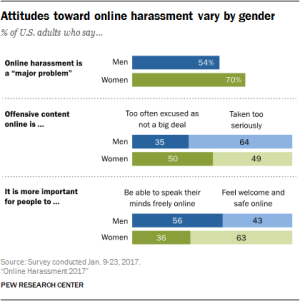
The number of journalists covering the statehouse varies dramatically from state to state, with some capitols filled with dozens of full-time reporters and others playing host to only two or three.
What accounts for these differences in staffing? We looked at several factors that could conceivably be connected to the number of reporters assigned to a statehouse. These included the length of legislative sessions, the number of legislators serving in a statehouse and a series of demographic factors including population size, income and education levels, age, race and ethnicity, percentage of residents living below the poverty line and the urban-rural breakdown.
Some variables that might have correlated to the size of a statehouse reporting corps were difficult to compare across states, since each state has a different way of doing and categorizing legislative work. For example, researchers examined numbers of bills passed per state, but the accounting varies too much from one state to the next to make a fair comparison across states possible.
Of the factors examined by Pew Research, a state’s population and the length of its legislative session both have a strong association with the size of a statehouse press corps. In general, states with more residents and states that have longer legislative sessions tend to have relatively large numbers of full-time reporters.5
Of the 10 most populous states—California, Texas, New York, Florida, Illinois, Pennsylvania, Ohio, Michigan, Georgia and North Carolina—all but the last two are among those with the 10 largest full-time statehouse press corps.
The pattern is somewhat less consistent among smaller states. Of the 10 least populous states—Wyoming, Vermont, North Dakota, Alaska, South Dakota, Delaware, Montana, Rhode Island, New Hampshire and Maine—half rank in the bottom 10 for the size of their press corps.

It is true that South Dakota, which is the fifth least populous state, has the smallest full-time statehouse press corps in the country, with just two full-time reporters: one writes for six newspapers and the other for the Associated Press. But Vermont, the second-smallest state in population, has 13 full-time statehouse reporters—more than 25 other states.
There are also substantial differences in the number of statehouse reporters among states that are similar in population. Illinois, Pennsylvania and Ohio are roughly comparable, with 12.8 million, 12.7 million and 11.5 million residents, respectively. But Ohio, the least populous of the three, has considerably more full-time statehouse reporters—32—than Illinois (22) or Pennsylvania (24).
Likewise, Missouri, Maryland, Wisconsin, Minnesota and Colorado have between 5 million and 6 million residents apiece. Yet Minnesota has three times as many full-time statehouse reporters as Colorado—21 vs. seven. The others range between 12 (Maryland) and 19 (Wisconsin).
The number of full-time reporters covering a statehouse is one way to measure how the public gets state government news. Yet another way to think about coverage is to consider how many statehouse reporters there are per capita. The average among all states is one reporter for every 373,777 people.
Although California has more full-time statehouse reporters than any state save one, it is so populous that it actually has the fewest number of reporters per resident. In California, there are 866,371 people per statehouse reporter.
Mississippi, a much smaller state, is second to California when it comes to the highest number of residents for each statehouse reporter. With only four full-time reporters, the ratio there is one reporter for every 741,824 people. Next is Colorado, with 718,457 people for each of its seven full-time reporters.
On the other end of the spectrum is tiny Vermont, which has 13 full-time reporters in the statehouse year-round—one for every 48,134 residents. Alaska has one reporter for every 88,779 people and Wyoming, the least populous state, has one reporter for every 93,938 people.
When the states are grouped by regions, there is one thing that stands out: Generally speaking, Western states have fewer reporters than states in the Northeast, South and Midwest. Of the 13 states in the West, nine have fewer than 10 full-time, year-round statehouse reporters. Three Western states (Arizona, Washington and Idaho) have 10-14 reporters and only one—California—has more than that.
By contrast, among the 13 states in the Midwest, just three have fewer than 10 full-time, year-round statehouse reporters. Two Midwestern states have 10-14 reporters, five have 15-19 reporters and three—Ohio, Illinois and Minnesota—have more than 20.
In addition to population, the amount of time a state legislature spends in session correlates to the number of reporters. Of the 10 states with the longest legislative sessions—based on the average length of the past two sessions ( in 2012 and 2013)—eight of them also ranked in the top 10 in the number of full-time statehouse reporters.

For example, California, where the session lasts an average of 12 months, has the second-largest full-time press corps, at 43 reporters. Wisconsin, which also has a 12-month session, ties for 10th in the number of full-time reporters (19), while New Jersey and New York, also at 12 months each, have 37 and 39 reporters, respectively.
Viewed another way, eight of the 11 states with the largest full-time press corps also ranked in the top 10 for the length of their legislative sessions.6 The outliers are Texas, which ranks first for the size of its press corps (53) but 18th for average session length (less than five months in biennial sessions); Florida, which ranks fifth in its press corps size (33) and 46th for average session length (two months); and Minnesota, which is ninth for its press corps size (21) and 24th, along with three other states, for session length (four months).
None of the other factors that Pew Research examined has a correlation with the number of statehouse reporters.






